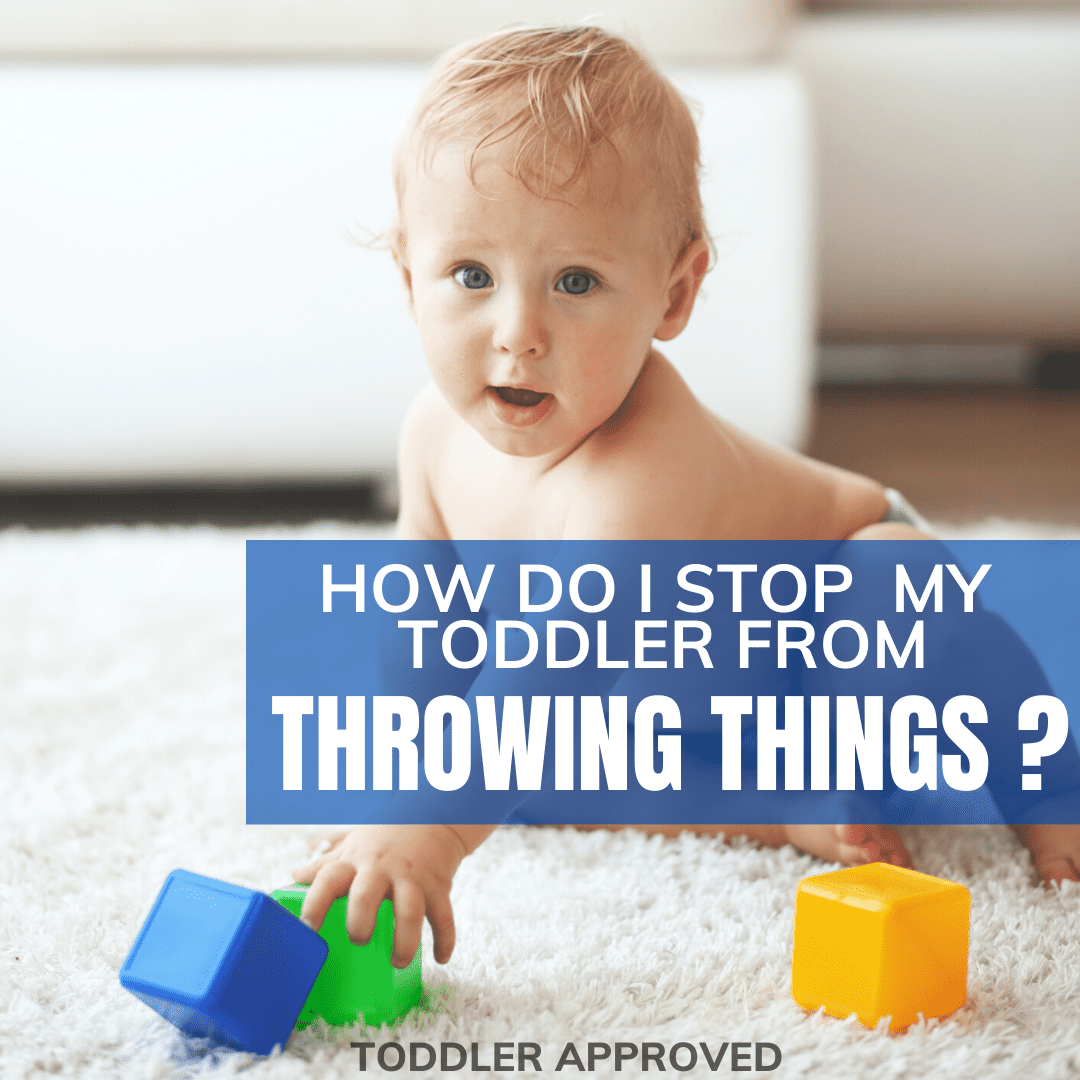Do you want to know how to get your toddler to stop throwing things? The best way to stop this common toddler behavior is to first figure out why they are throwing, then use positive strategies like redirection, teaching alternative behaviors, and using consistent consequences. This article will give you all the tips and tricks you need to manage your toddler’s throwing.

Image Source: toddlerapproved.com
Deciphering Toddler Throwing Behavior
Toddler throwing behavior is a very common stage. It can be frustrating for parents, but it’s important to remember that toddlers are still learning about the world and how to control their bodies and emotions.
Reasons Toddler Throws: Why Do They Do It?
There are many reasons for toddler throwing behavior. It’s rarely about being “naughty.” Some common reasons include:
- Experimentation: Toddlers are scientists! They’re exploring gravity, cause and effect, and how things move. A toddler throwing objects is often just testing what happens when they let go.
- Attention Seeking: If throwing gets a reaction (even a negative one), a toddler throwing objects might do it again to get your attention.
- Frustration or Anger: Toddler throwing tantrums can be a way to express big emotions they don’t yet know how to handle.
- Boredom: When bored, a toddler throwing behavior might begin simply because they have nothing else to do.
- Physical Development: Developing motor skills involves refining aim and force. Throwing is part of this process.
- Lack of Impulse Control: Toddlers are still developing self-control. They may not be able to stop themselves from throwing in the moment.
Is It Normal? Age-Related Expectations
Yes, toddler throwing behavior is generally normal, especially between the ages of 1 and 3. However, the way you address it is important.
Here’s a general breakdown:
- 12-18 Months: Experimentation is the main driver. They’re learning what happens when they drop or toss something.
- 18-24 Months: Throwing becomes more intentional. They might throw to see your reaction or to get something they want.
- 2-3 Years: Emotional throwing becomes more common. They might throw when angry, frustrated, or excited.
If throwing becomes frequent, aggressive, or continues beyond age 3, it’s a good idea to talk to your pediatrician.
Strategies For Managing Toddler Throwing
Now, let’s explore some practical strategies for managing toddler throwing behavior. Consistency is key!
Redirect Toddler Throwing: Offering Alternatives
One of the best ways to deal with toddler throwing is to redirect the behavior. Redirect toddler throwing by offering a suitable alternative.
- Designated Throwing Zone: Create a space where throwing is allowed, like a soft ball pit or an open area outside.
- Safe Throwing Objects: Provide soft balls, beanbags, or lightweight toys that are safe for throwing.
- Engaging Activities: Offer activities that channel their energy, like playing catch, tossing beanbags into a target, or rolling balls.
Teaching Appropriate Behavior: What To Do Instead
Help your toddler learn what to do instead of throwing.
- Model Good Behavior: Show them how to gently place objects down.
- Verbal Cues: Use simple phrases like, “We put toys down nicely,” or “Gentle hands.”
- Positive Reinforcement: Praise and reward them when they handle objects carefully.
Setting Clear Boundaries: What Is and Isn’t Allowed
Establish clear and consistent rules about what can and cannot be thrown.
- Explain the Rules: Tell your toddler, in simple terms, “We don’t throw toys inside. We only throw balls outside.”
- Be Consistent: Enforce the rules every time, without exception.
- Use Visual Aids: For older toddlers, consider using a picture chart to illustrate the rules.
Stop Toddler Throwing Food: Mealtime Strategies
Toddler throwing food is a particularly common and frustrating problem. Here’s how to tackle it:
- Rule Out Medical Issues: Firstly, rule out any medical reasons for the behavior.
- Small Portions: Offer small portions of food at a time. This reduces the temptation to throw large amounts.
- Ignore the Behavior: If they throw food for attention, try to ignore it. Don’t give them the reaction they’re seeking. Remove the food without saying anything.
- End the Meal: If throwing continues, calmly end the meal. Say something like, “If you’re going to throw your food, it looks like you’re finished eating.”
- Offer Alternatives: Make sure your toddler is offered a variety of food options. Sometimes, throwing food is a sign that they don’t like what’s being offered.
- Consistent Mealtime Routine: Creating a consistent and calming routine during meals can help minimize the frequency of food-throwing.
- Sensory Sensitivities: Be aware of potential sensory issues that make eating difficult (textures, smells, temperatures).
Consequences for Throwing: Responding Effectively
When your toddler throws something inappropriately, it’s important to respond with a consequence.
- Time-Out: A short time-out (1 minute per year of age) can be effective for older toddlers who understand the concept.
- Removal of the Object: If they throw a toy, take it away for a short period.
- Verbal Correction: Use a firm but calm tone to say, “No throwing. That hurts.”
- Avoid Overreacting: Try to stay calm. Overreacting can reinforce the behavior.
- Consistency: Apply the consequence every time they throw inappropriately.
- Example: Let’s say your child throws a block. You could say firmly, “We don’t throw blocks. Throwing blocks is not safe.” Then, remove the block and redirect their attention to another activity.
Managing Toddler Throwing Tantrums: Emotional Regulation
If toddler throwing tantrums are behind the behavior, focus on helping your toddler regulate their emotions.
- Teach Emotion Words: Help them learn to identify and name their feelings. “I see you’re angry.”
- Offer Comfort: Provide comfort and reassurance when they’re upset.
- Teach Calming Strategies: Show them how to take deep breaths, count to ten, or squeeze a soft toy.
- Model Calm Behavior: Show them how you manage your own emotions in a healthy way.
What Not To Do: Mistakes To Avoid
Here are some common mistakes parents make when dealing with toddler throwing:
- Yelling or Shouting: This can scare your child and make the situation worse.
- Physical Punishment: Never hit or spank your child. This is harmful and ineffective.
- Inconsistency: Not enforcing the rules consistently can confuse your child.
- Giving In: Giving in to their demands after they throw something reinforces the behavior.
- Ignoring the Behavior: While ignoring attention-seeking throwing can work, ignoring throwing that is harmful or destructive is never appropriate.
Preventative Measures: Setting the Stage for Success
Proactive strategies can help minimize throwing incidents.
Childproofing the Environment
Make your home safe by removing breakable objects and sharp items from your toddler’s reach.
Remove anything that could be tempting to throw.
Providing Plenty of Opportunities for Physical Activity
Ensure your toddler gets plenty of exercise and outdoor play. This helps them burn off energy and reduces the likelihood of boredom-related throwing.
Schedule regular physical activities, like playing in the park, going for walks, or dancing to music.
Ensuring Adequate Sleep and Nutrition
Well-rested and well-fed toddlers are less likely to be irritable and prone to throwing.
Establish a consistent sleep schedule and offer nutritious meals and snacks.
When to Seek Professional Help
While toddler throwing behavior is usually normal, there are times when it’s important to seek professional help.
- Frequent and Aggressive Throwing: If your toddler is throwing things frequently and aggressively, especially at people or animals.
- Developmental Delays: If your toddler has developmental delays or other concerns.
- Difficulty Managing Emotions: If your toddler has significant difficulty managing their emotions, even beyond throwing.
- Parental Stress: If you’re feeling overwhelmed and struggling to manage your toddler’s behavior, don’t hesitate to seek support from your pediatrician, a child psychologist, or a parenting coach.
Real-Life Examples: Scenarios and Solutions
Here are some real-life scenarios and potential solutions:
Scenario 1: Your toddler throws their toy truck across the room because they can’t get it to roll properly.
- Solution: Acknowledge their frustration: “I see you’re frustrated that the truck isn’t working.” Help them fix the truck or offer an alternative toy.
Scenario 2: Your toddler throws food at the dinner table because they don’t like what you’ve served.
- Solution: Calmly remove the food without making a fuss. Say, “It looks like you’re finished eating.” Offer a healthy alternative if they’re still hungry.
Scenario 3: Your toddler throws a tantrum in the store and starts throwing items off the shelves.
- Solution: Remove your toddler from the situation immediately. Take them to a quiet place where they can calm down. Acknowledge their feelings and offer comfort.
Resources for Parents
- Your Pediatrician: They can provide advice and referrals to specialists if needed.
- Parenting Books and Websites: There are many excellent resources available online and in libraries.
- Parenting Classes: These classes can provide you with tools and strategies for managing challenging behaviors.
- Support Groups: Connecting with other parents who are experiencing similar challenges can be incredibly helpful.
Fathoming Emotional Development & Its Impact on Throwing
A child’s emotional development stage greatly influences their behaviors, including throwing. Children are still learning to identify and manage their feelings, which is why emotional outbursts are common.
Emotional Intelligence
Emotional intelligence, or EQ, is the ability to understand, use, and manage one’s own emotions in positive ways to relieve stress, communicate effectively, empathize with others, overcome challenges and defuse conflict. Children with well-developed emotional intelligence are more likely to handle frustration and anger without resorting to behaviors like throwing.
Helping Build Emotional Resilience
- Modeling Emotions: Parents can model emotional regulation by showing how they handle their own stress and frustrations.
- Teaching Emotion Vocabulary: Helping a child learn to name their feelings (“You seem angry”) helps them understand and communicate these emotions.
- Practicing Calming Techniques: Deep breathing, counting to ten, and taking a break can help a child manage overwhelming emotions.
By focusing on emotional development, parents can teach children constructive ways to express themselves, reducing incidents of emotional throwing.
Frequently Asked Questions (FAQ)
Q: What is the most important thing to remember when dealing with toddler throwing?
A: Consistency is key. Enforce the rules every time, without exception.
Q: Can I ignore toddler throwing behavior?
A: It depends. If it’s attention-seeking throwing and not harmful, ignoring it might work. However, you should never ignore throwing that is dangerous or destructive.
Q: What if my toddler throws things when they’re angry?
A: Help them learn to identify and manage their anger. Teach them calming strategies and offer comfort.
Q: Is it okay to put my toddler in time-out for throwing?
A: Yes, time-out can be an effective consequence for older toddlers who understand the concept.
Q: When should I be concerned about my toddler’s throwing?
A: If the throwing is frequent, aggressive, or continues beyond age 3, it’s a good idea to talk to your pediatrician.
Dealing with toddler throwing can be challenging, but with patience, consistency, and the right strategies, you can help your toddler learn to manage their behavior and express their emotions in healthy ways.

Clark Lubowitz is a parenting expert with over 10 years of experience in toddler care and child development. Holding a degree in Early Childhood Education, he specializes in blending modern technology with parenting, offering expert advice on the best toddler gadgets. Through his work on ToddlerAwesome.com, Clark provides valuable insights to help parents make informed decisions for their little ones.
